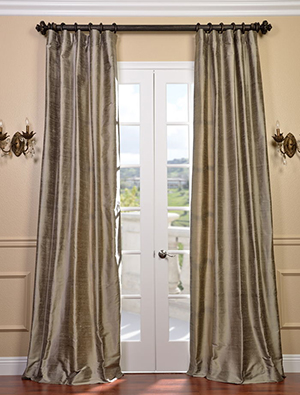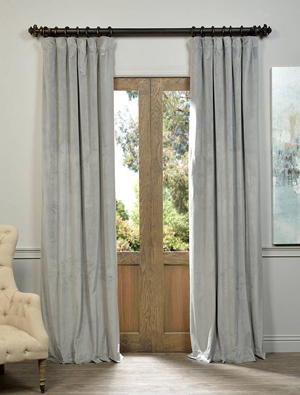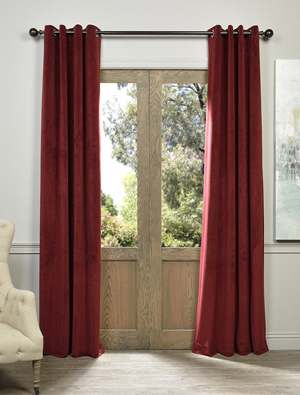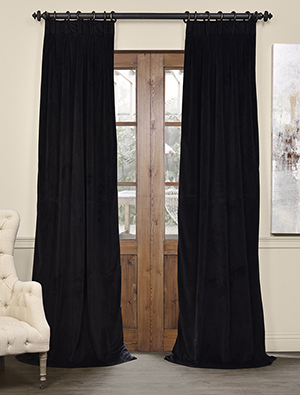Curtains are window treatments that perform several important tasks in your home. They help to create the desired mood you want to convey, and they also contribute pattern, color and texture that can enhance the look and style of the room’s décor. Curtains help to regulate the flow of natural light into the room, by either blocking it or letting it through. When choosing curtains for your home, it’s important to keep all of these tasks and characteristics in mind. There are some other considerations you’ll also want to review, so we invite you to read on for helpful information on the topic of selecting, maintaining and caring for your curtains.
Sheer, Opaque or Lace Curtains
Sheer curtains let in substantial amounts of light, whereas opaque curtains do not allow much, or any, light to pass through. Blackout curtains are available for those who want to block out light, or reduce heating or cooling costs.
Lace curtains are another possibility, offering a compromise of sorts between sheer and opaque curtains. Lace curtains feature open areas that allow some light to flow through.
Curtain Materials
Silk Curtains:

Silk curtains can evoke an aura of both lightness and luxury, making them ideal for use in homes that incorporate traditional style, romantic style, or period styles such as Rococo style. If you’re aiming for a mood of opulence, luxury, or romance, silk curtains are possibilities for achieving the look.
For best results, choose silk curtains that have linings.
Velvet Curtains:

The term “velvet” actually describes the construction of the curtain fabric, rather than the fiber contents; therefore it’s possible to find velvet curtains in a variety of different fibers. There are synthetic velvets, silk velvets, linen velvets, cotton velvets, and poly/cotton velvets, just to name just a few possibilities.
Velvet curtains are frequently lined.
Linen Curtains:
Linen drapes well, and is ideally suited for making curtains.
Original vintage linen curtains are prized by many collectors who decorate with period antiques.
Linen curtains are right at home in cottage bungalows, craftsman houses, or any environment decorated with mission furniture or arts and crafts furniture. See Also: Decorating a craftsman home with vintage furnishings.
Other Curtain Materials: Curtains can be made from just about any sort of fabric, including synthetics, cotton, poly-cotton, and other blends.
Curtain Styles
Rod-Pocket Curtains:
This easy, straightforward style of curtain features a flat upper edge. There are couple of different ways you could hang this type of curtain. Some people choose to push the curtain rod directly through the pocket at the upper edge of the curtain, skipping the use of rings, hooks or other hardware for hanging. This results in a style that is easiest to leave in one position; if you like this look, you might wish to leave the curtains open, then add blinds or a shade underneath to regulate the flow of light.
Other peoples utilize hardware to hang this style of curtains, typically incorporating the use of drapery hooks and rings. This allows for maximum versatility when opening or closing the curtains.
Other names for this style of curtain are “rod top curtains,” “pole top curtains” and “tailored curtains.”
Grommet-Top Curtains:

The curtain rod is threaded directly through the grommets or eyelet holes in this style of curtain. There’s an alternative name for this type of curtain: “eyelet curtains.”
Tab-Top Curtains: Decorative tabs give a casual appearance to this style of curtain. These work well for decorating a variety of different home styles, including country-style homes, transitional homes and contemporary homes.
Tie-Top Curtains: Some curtains incorporate ties that can be used to tie the curtain to the hardware or the curtain rod.
Pleated Curtains

You’ll encounter a variety of creative ways the tops of your curtains could be pleated. A few possibilities are as follows:
French-Pleated Curtains: This is a fancy decorative curtain top treatment requiring hardware, typically hooks and rings, that attaches the curtain to the rod.
Pencil-Pleated Curtains:
This is a versatile curtain style that’s appropriate for use with many different types of home décor, and many different curtain fabrications.Pinch-Pleated Curtains: This is yet another style of pleating that utilizes hooks and rings to attach the curtain to the rod.
Café Curtains:
This style of curtain is often seen in the kitchen or bathroom. It can incorporate a short valance at the upper part of the window, and short drapes at the lower part. Café curtains are popular with both country-style decorators and traditional decorators.
Roman Blinds:
There are various ways to construct Roman blinds, but in most cases, the result is a sort of hybrid in function between a window shade and a curtain. Roman blinds look like flat window shades when they are closed. Depending on the style, they can resemble either window shades or curtains when opened.
Ruffled Curtains: Ruffled curtains remain popular with some traditional decorators in the American northeast, with cape cod style homes occasionally incorporating this sort of look.
Valance Styles
Valances are not at peak popularity at the moment, but they have their place in decorating many traditional homes. Valances are useful for achieving certain period styles of décor, and for adding a finished look to certain room styles.
Swags and Cascades:
These are artfully draped valances that can be used by themselves at the top of the windows, or they can be layered overtop of sheers, window shades, blinds, or other draperies.
Pleated Window Valances:
Various styles of pleats can be incorporated into short valances layered overtop of other curtains, or used alone.
Getting the Best Value for the Money You Spend on Curtains
If you want to get the maximum return on the money you spend on your curtains, choose curtains made from fabrics that are designed with lightfast properties. This is important, since curtains are prone to fading from chronic exposure to direct sunlight.
The lightfastness (or lack thereof) is typically determined by a combination of several factors: the fiber contents, the dyes or coloring agents used, the dyeing or printing techniques used, any fixatives used, the finishing techniques used, and the correct handling and application of all substances to the fabric.
Correct storage, handling and care also play a part in the lightfastness after you’ve brought the curtains home.
If you have your heart set on curtains made from fragile fabrics, look for curtains that include protective linings.
Care and Maintenance of Curtains
There are some curtains that you could wash at home. Others need to be dry cleaned for best results. Refer to the manufacturer’s instructions for best results when laundering.
DIY Curtains

If you’re a creative do-it-yourselfer, you can easily make your own curtains. There are many possible approaches to this task; most require a sewing machine, some fabric, coordinating thread, and a pattern. The pattern isn’t strictly necessary, because you can easily make the simplest of curtains without one.
If you have the know-how plus substantial patience, you could also crochet or knit your own curtains.
Filet crochet is a popular technique for making flat curtain panels. In parts of Europe, you often see windows or openings built into the front doors, with these sorts of curtains covering them.
For filet crochet curtains, you’d typically use crochet thread and a small steel crochet hook.
If you dye your own curtains, be sure to use lightfast dyes such as fiber reactive dyes for cellulose fibers, or acid dyes for protein fibers. Absolutely do not use direct dyes such as Rit Dye, because the curtains will fade too quickly from sunlight exposure.
Enhancing the View With Curtains
If you have a room in which a window is the focal point, you’ll want to choose curtains that enhance the entire scene.
Ideally, the curtains should function in the same sort of way that your picture frames do. A frame is intended to encompass your beloved pictures; it’s the picture that’s important, and the frame is insignificant in comparison. In the same spirit, when you’re gifted with a stunning view from your window, let the view steal the show; choose curtains that complement the view rather than competing with it.
On the other hand, if your windows face a dreary scene you’d rather avoid looking at, you can use your curtains to distract from the view. You may wish to add a translucent window shade as well, or perhaps some interesting sun-catchers.
Shopping for Curtains
When you shop for curtains, it’s a good idea to ask about their return policy, and make sure the curtains are returnable in case they don’t end up looking quite like you expected once you get them home.
Now that you understand more about choosing curtains for your home, you’re better equipped to make the right decisions when you go shopping. Best wishes for selecting curtains that will be attractive, long-wearing and ideal for your living space.
More About Window Coverings
More About Home Decor
Interior Design Trends for 2018
- 2017 Home Design Trends
- 2018 Bathroom Remodeling Trends-
- Fresh Kitchen Trends for 2018
- Paint and Color Trends for 2018
Page last updated 9-1-2023.
choosing-curtains-for-your-home
Learn about many different considerations for choosing curtains: how to get the best value; different curtain styles, the best materials; and much more.
choosing curtains for your home, best curtain materials, curtain styles, silk curtains, velvet curtains, lace curtains, sheer curtains, roman blinds, pleated curtains, rod pocket curtains, blackout curtains